EPCHEM137 - Lithium-Ion Battery Research: Chemistry & Applications
VerifiedAdded on 2023/06/10
|6
|1309
|481
Report
AI Summary
This research report delves into the intricacies of lithium-ion batteries, beginning with an introduction to batteries and their energy storage capabilities, specifically focusing on lithium-ion batteries and their increasing importance. Part A identifies the key components of lithium-ion batteries, including the cathode, anode, separator, and electrolyte, emphasizing their crucial roles in battery functionality. The report explains the process of power generation and storage, highlighting the movement of lithium ions between electrodes during charging and discharging. It further examines the chemical reactions involved, using Lithium Nickel Manganese Cobalt Oxide as a case study, detailing the oxidation and reduction processes at the anode and cathode. Part B explores current applications of lithium-ion batteries, such as powering electric vehicles, storing solar energy, and enabling portable equipment, while Part C discusses potential future uses, particularly in electric vehicles and power backup systems, addressing the challenges associated with their implementation, including cost and user understanding. The report concludes by summarizing the benefits and challenges of lithium-ion battery technology, underscoring their potential for future applications despite existing hurdles.

Research report
Paraphrase This Document
Need a fresh take? Get an instant paraphrase of this document with our AI Paraphraser
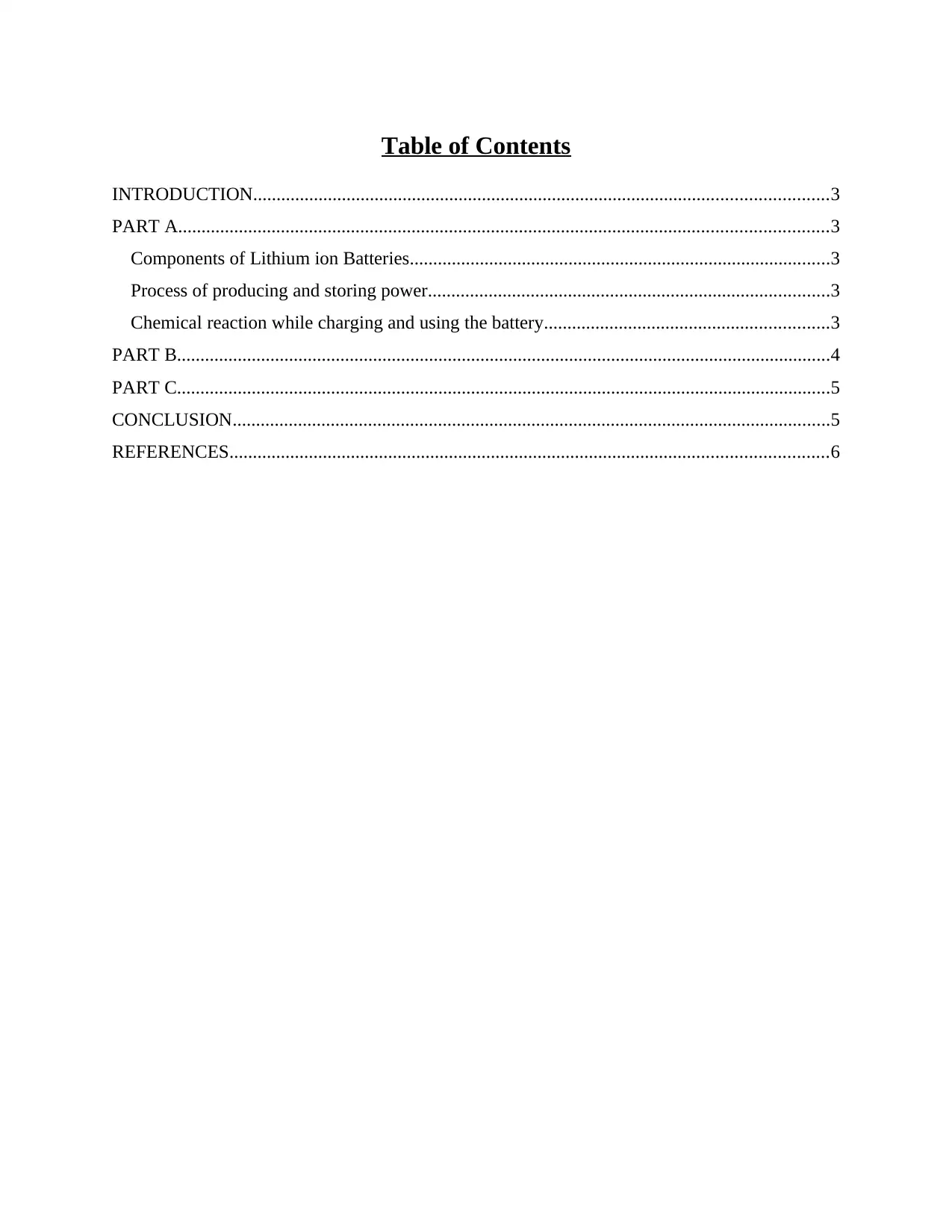
Table of Contents
INTRODUCTION...........................................................................................................................3
PART A...........................................................................................................................................3
Components of Lithium ion Batteries..........................................................................................3
Process of producing and storing power......................................................................................3
Chemical reaction while charging and using the battery.............................................................3
PART B............................................................................................................................................4
PART C............................................................................................................................................5
CONCLUSION................................................................................................................................5
REFERENCES................................................................................................................................6
INTRODUCTION...........................................................................................................................3
PART A...........................................................................................................................................3
Components of Lithium ion Batteries..........................................................................................3
Process of producing and storing power......................................................................................3
Chemical reaction while charging and using the battery.............................................................3
PART B............................................................................................................................................4
PART C............................................................................................................................................5
CONCLUSION................................................................................................................................5
REFERENCES................................................................................................................................6
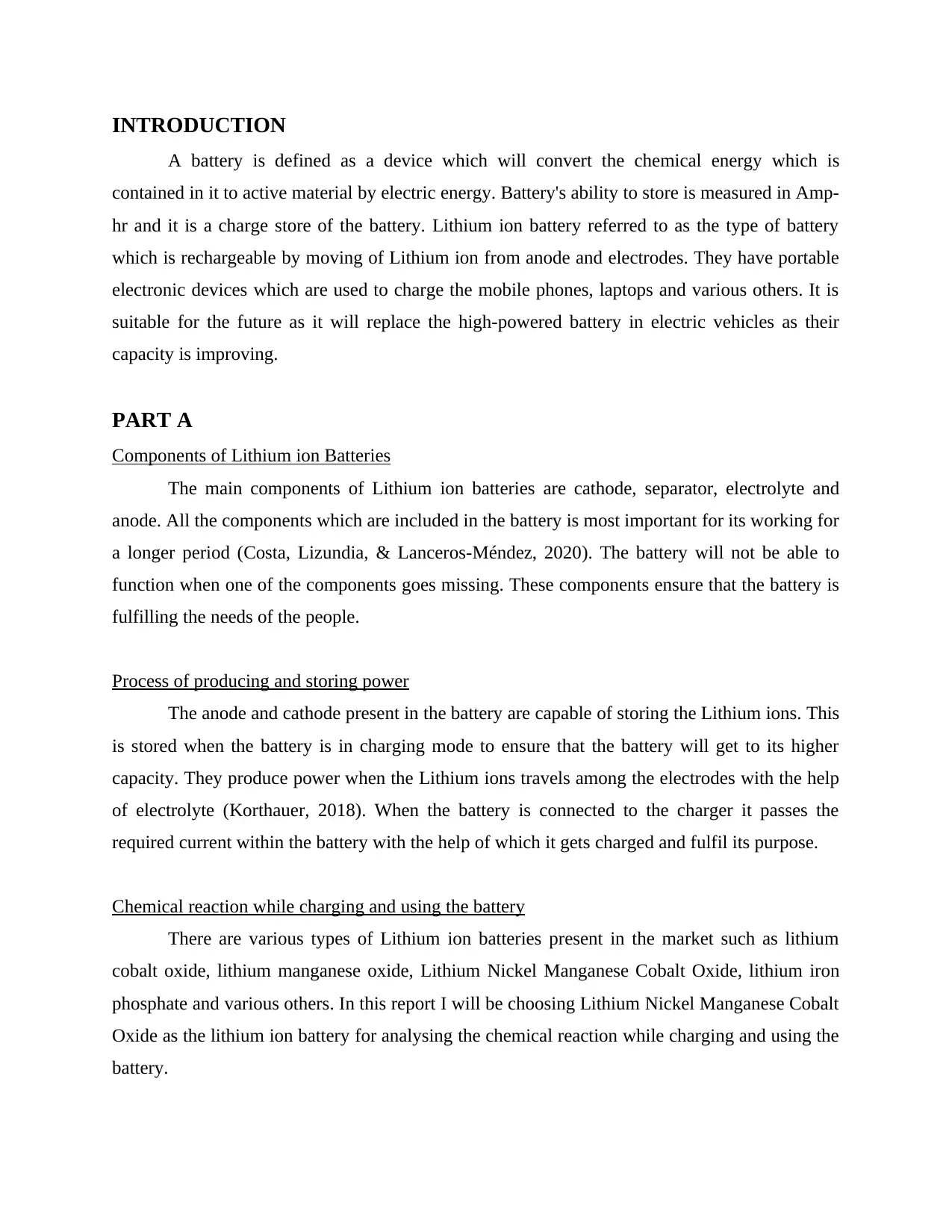
INTRODUCTION
A battery is defined as a device which will convert the chemical energy which is
contained in it to active material by electric energy. Battery's ability to store is measured in Amp-
hr and it is a charge store of the battery. Lithium ion battery referred to as the type of battery
which is rechargeable by moving of Lithium ion from anode and electrodes. They have portable
electronic devices which are used to charge the mobile phones, laptops and various others. It is
suitable for the future as it will replace the high-powered battery in electric vehicles as their
capacity is improving.
PART A
Components of Lithium ion Batteries
The main components of Lithium ion batteries are cathode, separator, electrolyte and
anode. All the components which are included in the battery is most important for its working for
a longer period (Costa, Lizundia, & Lanceros-Méndez, 2020). The battery will not be able to
function when one of the components goes missing. These components ensure that the battery is
fulfilling the needs of the people.
Process of producing and storing power
The anode and cathode present in the battery are capable of storing the Lithium ions. This
is stored when the battery is in charging mode to ensure that the battery will get to its higher
capacity. They produce power when the Lithium ions travels among the electrodes with the help
of electrolyte (Korthauer, 2018). When the battery is connected to the charger it passes the
required current within the battery with the help of which it gets charged and fulfil its purpose.
Chemical reaction while charging and using the battery
There are various types of Lithium ion batteries present in the market such as lithium
cobalt oxide, lithium manganese oxide, Lithium Nickel Manganese Cobalt Oxide, lithium iron
phosphate and various others. In this report I will be choosing Lithium Nickel Manganese Cobalt
Oxide as the lithium ion battery for analysing the chemical reaction while charging and using the
battery.
A battery is defined as a device which will convert the chemical energy which is
contained in it to active material by electric energy. Battery's ability to store is measured in Amp-
hr and it is a charge store of the battery. Lithium ion battery referred to as the type of battery
which is rechargeable by moving of Lithium ion from anode and electrodes. They have portable
electronic devices which are used to charge the mobile phones, laptops and various others. It is
suitable for the future as it will replace the high-powered battery in electric vehicles as their
capacity is improving.
PART A
Components of Lithium ion Batteries
The main components of Lithium ion batteries are cathode, separator, electrolyte and
anode. All the components which are included in the battery is most important for its working for
a longer period (Costa, Lizundia, & Lanceros-Méndez, 2020). The battery will not be able to
function when one of the components goes missing. These components ensure that the battery is
fulfilling the needs of the people.
Process of producing and storing power
The anode and cathode present in the battery are capable of storing the Lithium ions. This
is stored when the battery is in charging mode to ensure that the battery will get to its higher
capacity. They produce power when the Lithium ions travels among the electrodes with the help
of electrolyte (Korthauer, 2018). When the battery is connected to the charger it passes the
required current within the battery with the help of which it gets charged and fulfil its purpose.
Chemical reaction while charging and using the battery
There are various types of Lithium ion batteries present in the market such as lithium
cobalt oxide, lithium manganese oxide, Lithium Nickel Manganese Cobalt Oxide, lithium iron
phosphate and various others. In this report I will be choosing Lithium Nickel Manganese Cobalt
Oxide as the lithium ion battery for analysing the chemical reaction while charging and using the
battery.
⊘ This is a preview!⊘
Do you want full access?
Subscribe today to unlock all pages.

Trusted by 1+ million students worldwide
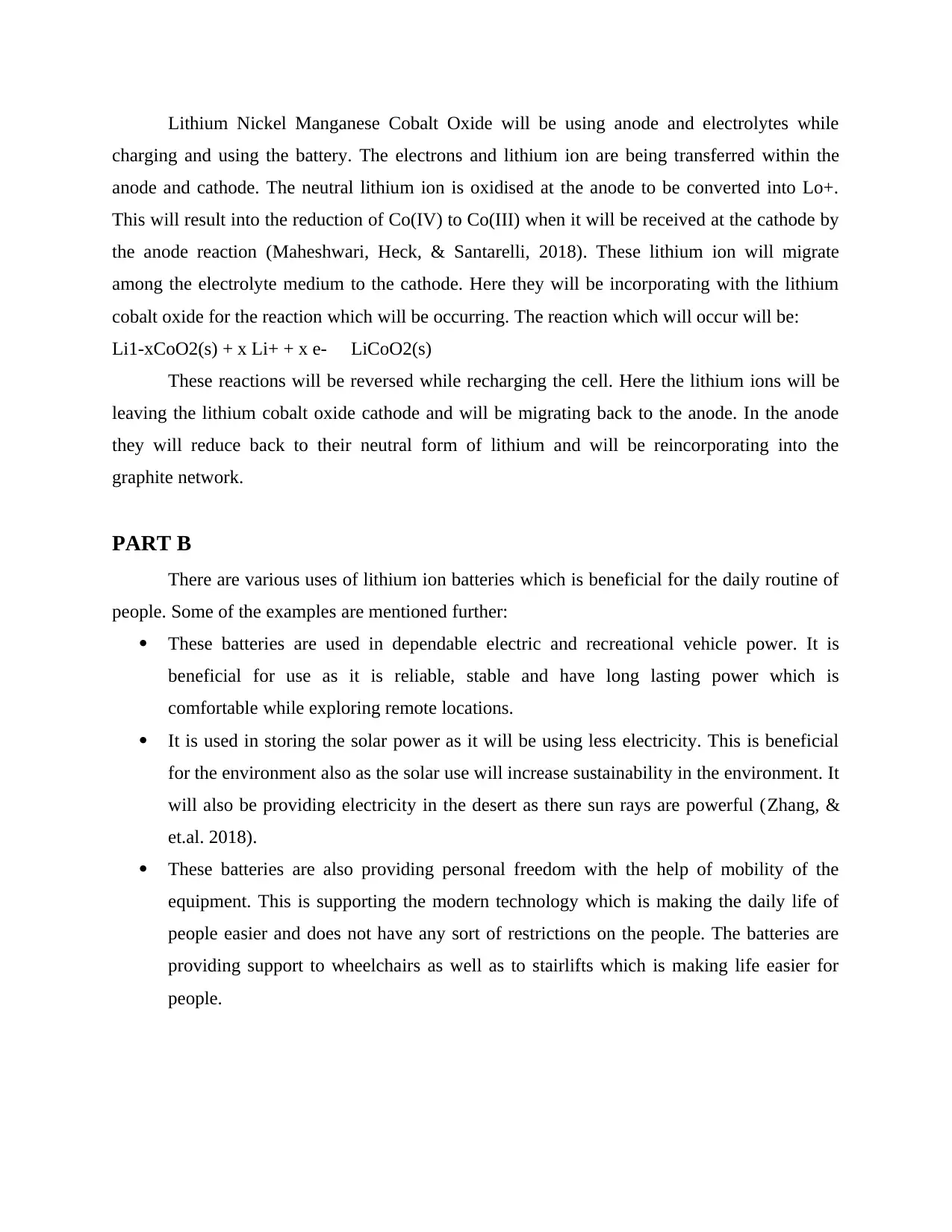
Lithium Nickel Manganese Cobalt Oxide will be using anode and electrolytes while
charging and using the battery. The electrons and lithium ion are being transferred within the
anode and cathode. The neutral lithium ion is oxidised at the anode to be converted into Lo+.
This will result into the reduction of Co(IV) to Co(III) when it will be received at the cathode by
the anode reaction (Maheshwari, Heck, & Santarelli, 2018). These lithium ion will migrate
among the electrolyte medium to the cathode. Here they will be incorporating with the lithium
cobalt oxide for the reaction which will be occurring. The reaction which will occur will be:
Li1-xCoO2(s) + x Li+ + x e- LiCoO2(s)
These reactions will be reversed while recharging the cell. Here the lithium ions will be
leaving the lithium cobalt oxide cathode and will be migrating back to the anode. In the anode
they will reduce back to their neutral form of lithium and will be reincorporating into the
graphite network.
PART B
There are various uses of lithium ion batteries which is beneficial for the daily routine of
people. Some of the examples are mentioned further:
These batteries are used in dependable electric and recreational vehicle power. It is
beneficial for use as it is reliable, stable and have long lasting power which is
comfortable while exploring remote locations.
It is used in storing the solar power as it will be using less electricity. This is beneficial
for the environment also as the solar use will increase sustainability in the environment. It
will also be providing electricity in the desert as there sun rays are powerful (Zhang, &
et.al. 2018).
These batteries are also providing personal freedom with the help of mobility of the
equipment. This is supporting the modern technology which is making the daily life of
people easier and does not have any sort of restrictions on the people. The batteries are
providing support to wheelchairs as well as to stairlifts which is making life easier for
people.
charging and using the battery. The electrons and lithium ion are being transferred within the
anode and cathode. The neutral lithium ion is oxidised at the anode to be converted into Lo+.
This will result into the reduction of Co(IV) to Co(III) when it will be received at the cathode by
the anode reaction (Maheshwari, Heck, & Santarelli, 2018). These lithium ion will migrate
among the electrolyte medium to the cathode. Here they will be incorporating with the lithium
cobalt oxide for the reaction which will be occurring. The reaction which will occur will be:
Li1-xCoO2(s) + x Li+ + x e- LiCoO2(s)
These reactions will be reversed while recharging the cell. Here the lithium ions will be
leaving the lithium cobalt oxide cathode and will be migrating back to the anode. In the anode
they will reduce back to their neutral form of lithium and will be reincorporating into the
graphite network.
PART B
There are various uses of lithium ion batteries which is beneficial for the daily routine of
people. Some of the examples are mentioned further:
These batteries are used in dependable electric and recreational vehicle power. It is
beneficial for use as it is reliable, stable and have long lasting power which is
comfortable while exploring remote locations.
It is used in storing the solar power as it will be using less electricity. This is beneficial
for the environment also as the solar use will increase sustainability in the environment. It
will also be providing electricity in the desert as there sun rays are powerful (Zhang, &
et.al. 2018).
These batteries are also providing personal freedom with the help of mobility of the
equipment. This is supporting the modern technology which is making the daily life of
people easier and does not have any sort of restrictions on the people. The batteries are
providing support to wheelchairs as well as to stairlifts which is making life easier for
people.
Paraphrase This Document
Need a fresh take? Get an instant paraphrase of this document with our AI Paraphraser
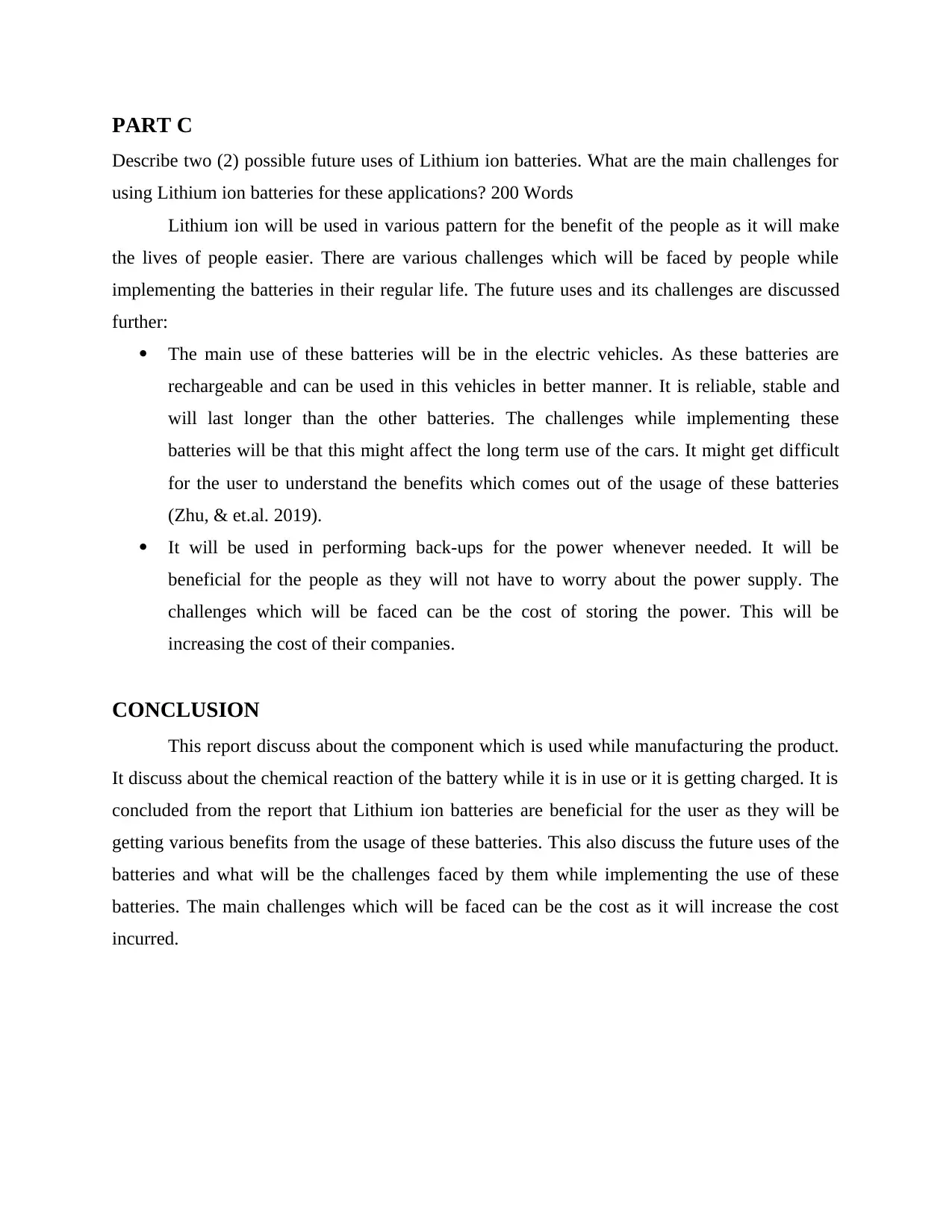
PART C
Describe two (2) possible future uses of Lithium ion batteries. What are the main challenges for
using Lithium ion batteries for these applications? 200 Words
Lithium ion will be used in various pattern for the benefit of the people as it will make
the lives of people easier. There are various challenges which will be faced by people while
implementing the batteries in their regular life. The future uses and its challenges are discussed
further:
The main use of these batteries will be in the electric vehicles. As these batteries are
rechargeable and can be used in this vehicles in better manner. It is reliable, stable and
will last longer than the other batteries. The challenges while implementing these
batteries will be that this might affect the long term use of the cars. It might get difficult
for the user to understand the benefits which comes out of the usage of these batteries
(Zhu, & et.al. 2019).
It will be used in performing back-ups for the power whenever needed. It will be
beneficial for the people as they will not have to worry about the power supply. The
challenges which will be faced can be the cost of storing the power. This will be
increasing the cost of their companies.
CONCLUSION
This report discuss about the component which is used while manufacturing the product.
It discuss about the chemical reaction of the battery while it is in use or it is getting charged. It is
concluded from the report that Lithium ion batteries are beneficial for the user as they will be
getting various benefits from the usage of these batteries. This also discuss the future uses of the
batteries and what will be the challenges faced by them while implementing the use of these
batteries. The main challenges which will be faced can be the cost as it will increase the cost
incurred.
Describe two (2) possible future uses of Lithium ion batteries. What are the main challenges for
using Lithium ion batteries for these applications? 200 Words
Lithium ion will be used in various pattern for the benefit of the people as it will make
the lives of people easier. There are various challenges which will be faced by people while
implementing the batteries in their regular life. The future uses and its challenges are discussed
further:
The main use of these batteries will be in the electric vehicles. As these batteries are
rechargeable and can be used in this vehicles in better manner. It is reliable, stable and
will last longer than the other batteries. The challenges while implementing these
batteries will be that this might affect the long term use of the cars. It might get difficult
for the user to understand the benefits which comes out of the usage of these batteries
(Zhu, & et.al. 2019).
It will be used in performing back-ups for the power whenever needed. It will be
beneficial for the people as they will not have to worry about the power supply. The
challenges which will be faced can be the cost of storing the power. This will be
increasing the cost of their companies.
CONCLUSION
This report discuss about the component which is used while manufacturing the product.
It discuss about the chemical reaction of the battery while it is in use or it is getting charged. It is
concluded from the report that Lithium ion batteries are beneficial for the user as they will be
getting various benefits from the usage of these batteries. This also discuss the future uses of the
batteries and what will be the challenges faced by them while implementing the use of these
batteries. The main challenges which will be faced can be the cost as it will increase the cost
incurred.
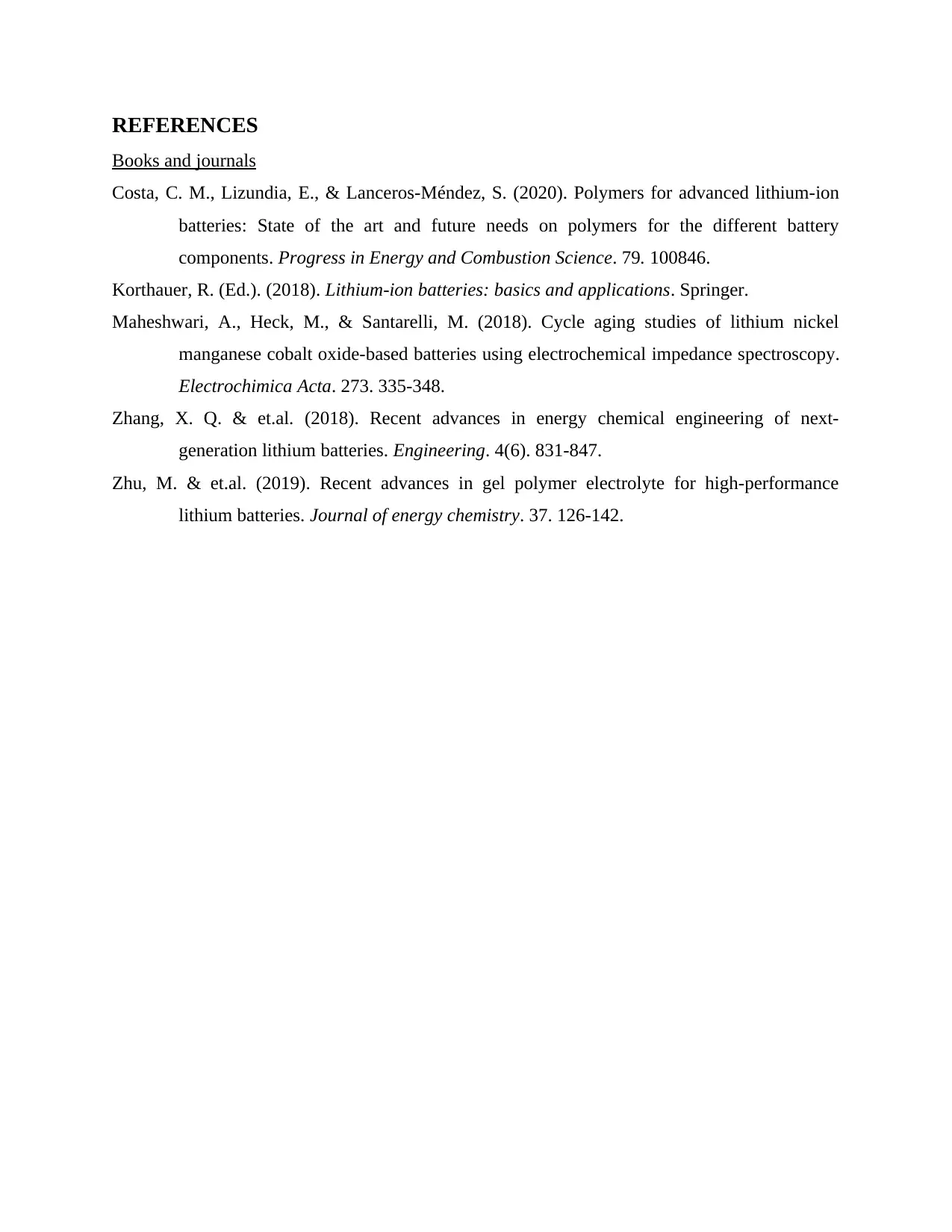
REFERENCES
Books and journals
Costa, C. M., Lizundia, E., & Lanceros-Méndez, S. (2020). Polymers for advanced lithium-ion
batteries: State of the art and future needs on polymers for the different battery
components. Progress in Energy and Combustion Science. 79. 100846.
Korthauer, R. (Ed.). (2018). Lithium-ion batteries: basics and applications. Springer.
Maheshwari, A., Heck, M., & Santarelli, M. (2018). Cycle aging studies of lithium nickel
manganese cobalt oxide-based batteries using electrochemical impedance spectroscopy.
Electrochimica Acta. 273. 335-348.
Zhang, X. Q. & et.al. (2018). Recent advances in energy chemical engineering of next-
generation lithium batteries. Engineering. 4(6). 831-847.
Zhu, M. & et.al. (2019). Recent advances in gel polymer electrolyte for high-performance
lithium batteries. Journal of energy chemistry. 37. 126-142.
Books and journals
Costa, C. M., Lizundia, E., & Lanceros-Méndez, S. (2020). Polymers for advanced lithium-ion
batteries: State of the art and future needs on polymers for the different battery
components. Progress in Energy and Combustion Science. 79. 100846.
Korthauer, R. (Ed.). (2018). Lithium-ion batteries: basics and applications. Springer.
Maheshwari, A., Heck, M., & Santarelli, M. (2018). Cycle aging studies of lithium nickel
manganese cobalt oxide-based batteries using electrochemical impedance spectroscopy.
Electrochimica Acta. 273. 335-348.
Zhang, X. Q. & et.al. (2018). Recent advances in energy chemical engineering of next-
generation lithium batteries. Engineering. 4(6). 831-847.
Zhu, M. & et.al. (2019). Recent advances in gel polymer electrolyte for high-performance
lithium batteries. Journal of energy chemistry. 37. 126-142.
⊘ This is a preview!⊘
Do you want full access?
Subscribe today to unlock all pages.

Trusted by 1+ million students worldwide
1 out of 6
Related Documents
Your All-in-One AI-Powered Toolkit for Academic Success.
+13062052269
info@desklib.com
Available 24*7 on WhatsApp / Email
![[object Object]](/_next/static/media/star-bottom.7253800d.svg)
Unlock your academic potential
Copyright © 2020–2025 A2Z Services. All Rights Reserved. Developed and managed by ZUCOL.





